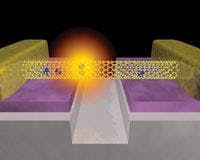Electrically stimulated carbon nanotubes emit IR light
Researchers from IBM (Yorktown Heights, NY) and Duke University (Durham, NC) have produced bright IR electroluminescence at local electric fields in the junction between suspended and supported parts of a partially suspended single-carbon-nanotube field-effect transistor in unipolar operation. Unlike light-emitting diodes or ambipolar carbon-nanotube field-effect transistors, in which electrons and holes are injected from source and drain electrodes separately, the unipolar device in the IBM-Duke experiment generated carriers locally when either electrons or holes were accelerated by electrical forces great enough to create strongly correlated electron-hole pairs.
The local unipolar mechanism led to a two- to three-orders-of-magnitude increase in electroluminescent efficiency over light emission by ambipolar carbon-nanotube field-effect transistors. The researchers attributed the effect to weak electron-phonon scattering and strong electron-hole binding caused by 1-D confinement. The combination of extraordinary current carrying and ultrasmall size in the carbon nanotube led to an ultrabright light source; the high excitation density allowed the researchers to observe emission from highly excited states that were not observable through photo-excitation. Contact Phaedon Avouris at [email protected].

